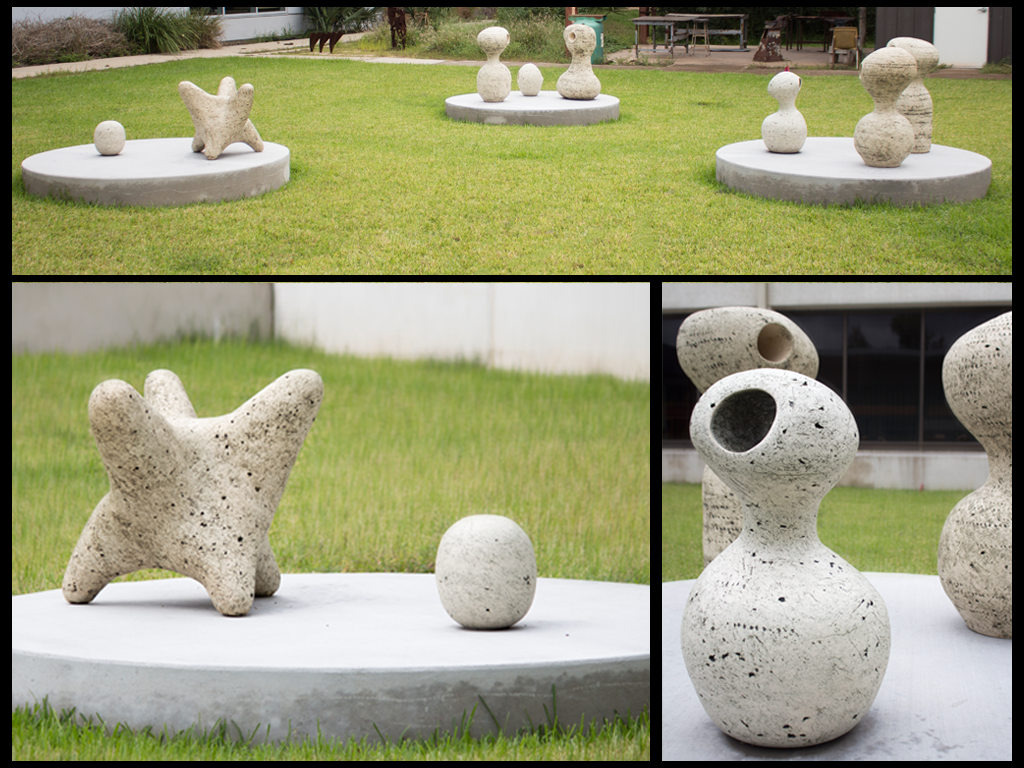
Retired professor leaves behind art legacy

Collage by the The Signal Reporter KeeLynn Hutchison.
Nick de Vries, recently retired professor of art, left to UHCL a lasting legacy in the form of art – the same subject he taught for 39 years. His sculpture, Frisian Horses, stands between the Arbor and Arbor North buildings.
This piece of art features three cement circles, each with ceramic sculptures that all connect and interact as one feature. Frisian Horses not only represents de Vries’ upbringing, but also his past experiences as an artist. He is a native of Friesland in the Netherlands, with a strong Dutch heritage.
The first piece features a caltrop, which is similar in look to a jack from the game Jacks. Caltrops were used as a defense mechanism in many wars. The Dutch used these forms as a way to protect themselves from Spanish attacks during World War II.
The Spanish, unlike the Dutch, had horses to use during attacks. In order to protect themselves, the Dutch would place the caltrops in the way of an approaching army in an attempt to slow down the horses.
The caltrop form is also a design de Vries used while teaching in Bratislava, the capital of Slovakia. He often taught there as part of the art consortium program between UHCL and the Academy of Art and Design in Bratislava.
When the Twin Towers were attacked Sept. 11, 2001, Americans barricaded the doors of all U.S. Embassies for protection from any future unknown attacks. The embassy in Slovakia created a dispute because Slovakian citizens felt the beauty of Bratislava’s downtown was disturbed by these barricades.
De Vries was in Slovakia teaching in September 2001. In an attempt to keep peace, de Vries was asked to create a series of artwork to display in the embassy. The series, Bridges, is the first time de Vries used caltrops in a design. Bridges represented a metaphor for the connection the U.S. hoped to make with the Slovakians at the time.
In carrying forward a piece from that series, de Vries created Frisian Horses in a more peaceful and inviting way.
“This form represents from that beginning to a more pleasant and human feel,” de Vries said. “Very soft, very quiet, very affirming for me and very peaceful.”
De Vries hopes the community can use his artwork as a way to connect with nature.
“I want people to be able to sit here and be a part of nature,” de Vries said. “I love nature.”
Jason Makepeace, assistant professor of sculpture, worked with de Vries for the past 13 years.
“The longevity of the piece, being his, will always be a reminder of what he helped and created with our program,” Makepeace said.
Sandria Hu, professor of drawing and painting, helped de Vries develop the art program in 1975.
“It’s his landmark,” Hu said. “It’s his aesthetic vision and gift to UHCL.”
De Vries worked on this piece for two years and said he is glad to be able to give to the UHCL community by doing what he loves most.
The work was funded by the University of Houston system as a way to provide artwork to campus buildings. Campus artwork is funded by 1 percent of a building’s budget.
The sculpture joins a collection of works around campus, including a painting by Hu and soon-to-be completed sculpture by Makepeace.
After giving so many years to this university, de Vries was pleased to be able to leave behind a symbol of his legacy through his artwork.
“It’s fantastic to leave something behind for the campus and the students,” de Vries said. “I’m very proud and honored.”
